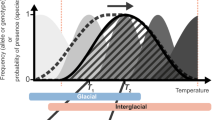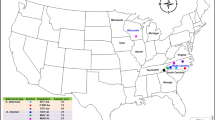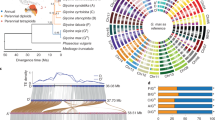Abstract
The genetic consequences of a bottleneck, and the spatial genetic structure within and between populations, were studied in the rare and geographically restricted species Stylidium coroniforme. Thirteen out of 15 aflozyme loci analysed were polymorphic. The level of polymorphism was relatively high for an insect-pollinated outcrossing species. In one population, which was subjected to a prolonged decline in numbers resulting in a bottleneck, probably of three plants, there was no measurable reduction in either allelic diversity of average heterozygosity. Maintenance of heterozygosity in this population could be attributed to rapid recovery after the bottleneck, the progressive elimination of selfed or otherwise inbred products during seed development and selection favouring heterozygotes as plants mature. Evidence for the latter was a significant decrease in the fixation index from younger (F = 0.28) to older plants (F = 0.14). Bottleneck-flush cycles are considered to be a major factor contributing to the relatively high level of differentiation observed between the three Wongan Hills populations, which suggests that the bottleneck observed was not atypical for these populations. The allozyme divergence between the two population systems within this taxon (D = 0.29) may be indicative of two different but morphologically cryptic species. Spatial autocorrelation techniques revealed no spatial genetic structure in one population sampled at its maximum density. It was concluded that high levels of genetic diversity in small populations are typical of S. coroniforme, which is relatively short lived, disturbance-adapted and has population systems which probably undergo frequent bottleneck-flush cycles.
Similar content being viewed by others
Article PDF
References
Banyard, B J, and James, S H. 1979. Biosystematic studies in the Stylidium crassifolium species complex (Stylidiaceae). Aust J Bot, 27, 27–37.
Brown, A H D. 1979. Enzyme polymorphisms in plant populations. Theor Pop Biol, 15, 1–42.
Brown, A H D. 1989. Genetic characterization of plant mating systems. In: Brown, A. H. D., Clegg, M. T., Kahler, A. L. and Weir, B. S. (eds) Plant Population Genetics, Breeding and Genetic Resources, Sinauer Associates, Sunderland, MA, pp. 145–162.
Brown, A H D, and Burdon, J J. 1983. Multilocus diversity in an outbreeding weed, Echium plantagineum L. Aust J Biol Sci, 36, 503–509.
Brown, A H D, and Weir, B A. 1983. Measuring genetic variability in plant populations. In: Tanksley, S. D. and Orton, T. J. (eds) Isozymes in Plant Genetics and Breeding, Elsevier, Amsterdam, pp. 219–239.
Burbidge, A H, and James, S H. 1991. Postzygotic seed abortion in the genetic system of Stylidium (Angiospermae: Stylidiaceae). J Hered, 82, 319–328.
Carson, H L, and Templeton, A R. 1984. Genetic revolutions in relation to speciation phenomena: the founding of new populations. Ann Rev Ecol Syst, 15, 97–131.
Coates, D J. 1981. Chromosome, morphometric and breeding system studies in the Stylidium caricifolium species complex (Stylidaceae). Aust J Bot, 27, 397–417.
Coates, D J. 1988. Genetic diversity and population genetic structure in the rare Chittering grass wattle Acacia anomala (Court) Aust J Bot, 36, 273–286.
Chakraborty, R, and Nei, M. 1977. Bottleneck effects on average heterozygosity and genetic distance with the stepwise mutation model. Evolution, 31, 347–356.
Dewey, S E, and Heywood, J S. 1988. Spatial genetic structure in a population of Psychotria nervosa. I. Distribution of genotypes. Evolution, 42, 834–838.
Erickson, R, and Willis, J H. 1966. Some additions to Australian Stylidiaceae. Vic Nat, 73, 43–44.
Hamrick, J L. 1989. Isozymes and the analysis of genetic structure in plant populations. In: Soltis, D. E. and Soltis, P. S. (eds) Isozymes in Plant Biology, Dioscorides Press, Portland, pp. 73–86.
Hamrick, J L, and Godt, M J. 1989. Allozyme diversity in plant species. In: Brown, A. H. D., Clegg. M. T., Kahler, A. L. and Weir, B. S. (eds) Plant Population Genetics, Breeding, and Genetic Resources, Sinauer Associates, Sunderland, MA, pp. 43–63.
Hopper, S D. 1982. Hand pollination of rare triggerplant successful. Swans, 12, 12–15.
James, S H. 1979. Chromosome numbers and genetic systems in the triggerplants of Western Australia. Aust J Bot, 27, 17–25.
Johnson, M S. 1988. Founder effects and geographic variation in the land snail Thebapisana. Heredity, 61, 133–142.
Lande, R, and Schemske, D W. 1985. The evolution of self-fertilization and inbreeding. 1. Genetic Models. Evolution, 39, 24–40.
Ledig, E T. 1986. Heterozygosity, heterosis, and fitness in outbreeding plants. In: Soule, M. E. (ed.) Conservation Biology, the Science of Scarcity and Diversity, Sinauer Associates, Sunderland, MA, pp. 77–104.
Levin, D A. 1984. Inbreeding depression and proximity-dependent crossing success in Phlox drummondii. Evolution, 38, 116–127.
McLenaghan, L R, and Beauchamp, A C. 1986. Low genie differentiation among isolated populations of the California fan palm (Washingtonia filifera). Evolution, 42, 315–322.
Mitton, J B. 1989. Physiological and demographic variation associated with allozyme variation. In: Soltis, D. E. and Soltis, P. S. (eds) Isozymes in Plant Biology, Dioscorides Press, Portland, pp. 127–145.
Mopper, S, Mitton, J B, Whitham, T G, Cobb, N S, and Christensen, K M. 1991. Genetic differentiation and heterozygosity in pinyon pine associated with resistance to herbivory and environmental stress. Evolution, 45, 989–999.
Moran, G F, and Hopper, S D. 1983. Genetic diversity and insular population structure of the rare granite rock species Eucalyptus caesia Benth. Aust J Bot, 31, 161–172.
Moran, G F, and Hopper, S D. 1987. Conservation of the genetic resources in of rare and widespread eucalypts in remnant vegetation. In: Saunders, D. A., Arnold, G. W., Burbidge, A. A. and Hopkins, A. J. M. (eds) The Role of Remnants of Native Vegetation, Surrey Beatty, Sydney, pp. 151–162.
Nei, M. 1978. Estimation of average heterozygosity and genetic distance from a small number of individuals. Genetics, 89, 583–590.
Nei, M, and Chesser, R K. 1983. Estimation of fixation indices and gene diversities. Ann Hum Genet, 47, 253–259.
Nei, M, Maruyama, T, and Chakrabroty, R. 1975. The bottleneck effect and genetic variability in populations. Evolution, 29, 1–10.
Perry, D J, and Knowles, P. 1990. Spatial genetic structure within sugar maple (Acer saccharum Marsh) stands. Heredity, 66, 137–142.
Plessas, M E, and Strauss, S H. 1986. Allozyme diffentiation among populations, stands, and cohorts in Monterey pine. Can J For Res, 16, 1155–1164.
Price, M V, and Waser, N N. 1979. Pollen dispersal and optimal outcrossing in Delphinium nelsonii. Nature, 277, 294–297.
Ritland, K. 1986. Joint maximum likelihood estimation of genetic and mating structure using open pollinated progenies. Biometrics, 42, 25–43.
Rye, B L. 1980. Rare and geographically restricted plants of Western Australia 4 Wongan Hills species. Unpublished report, Department of Fisheries and Wildlife, Perth.
Schaal, B A. 1980. Measurement of gene flow in Lupinus texensis. Nature, 284, 450–451.
Schwaegerle, K E, and Schaal, B A. 1979. Genetic variability and founder effect in the pitcher plant Sarracenia purpurea L. Evolution, 33, 1210–1218.
Slatkin, M. 1985. Rare alleles as indicators of gene flow. Evolution, 39, 53–65.
Slatkin, M, and Barton, N H. 1989. A comparison of three indirect methods for estimating average levels of gene flow. Evolution, 43, 1349–1368.
Sokal, R R, and Oden, N L. 1978. Spatial autocorrelation in biology. 1. Methodology. Biol J Linn Soc, 10, 199–228.
Swofford, D L, and Selander, R K. 1981. A computer program for the analysis of allelic variation in genetics. J Hered, 72, 281–283.
Taggert, J B, McNally, S F, and Sharp, P M. 1989. Genetic variability and differentiation among founder populations of the pitcher plant (Sarracenia purpurea) in Ireland. Heredity, 64, 177–183.
Waser, N M. 1987. Spatial genetic heterogeneity in a population of the montane perennial plant. Delphinium nelsonii Heredity, 58, 249–256.
Watkins, L, and Levin, D A. 1990. Outcrossing rates as related to plant density in Phlox drummondii. Heredity, 65, 81–90.
Weir, B S, and Cochran, C C. 1984. Estimating F statistics for the analysis of population structure. Evolution, 38, 1358–1370.
White, M J D. 1978. Modes of Speciation. Freeman, San Francisco.
Wright, S. 1951. The genetical structure of populations. Ann Eugen, 15, 323–354.
Author information
Authors and Affiliations
Rights and permissions
About this article
Cite this article
Coates, D. Genetic consequences of a bottleneck and spatial genetic structure in the triggerplant Stylidium coroniforme (Stylidiaceae). Heredity 69, 512–520 (1992). https://doi.org/10.1038/hdy.1992.166
Received:
Issue date:
DOI: https://doi.org/10.1038/hdy.1992.166
Keywords
This article is cited by
-
Genetic diversity and population structure of North America’s rarest heron, the reddish egret (Egretta rufescens)
Conservation Genetics (2012)
-
Genetic diversity within and divergence between rare and geographically widespread taxa of the Acacia acuminata Benth. (Mimosaceae) complex
Heredity (2002)
-
Genetic diversity in the monospecific Western Australian endemic, Geleznowia verrucosa Turcz. (Rutaceae)
Heredity (1999)
-
Genetic divergence and the mating system in the endangered and geographically restricted species, Lambertia orbifolia Gardner (Proteaceae)
Heredity (1999)
-
The ten cytological races of the Scilla autumnalis species complex
Heredity (1997)



